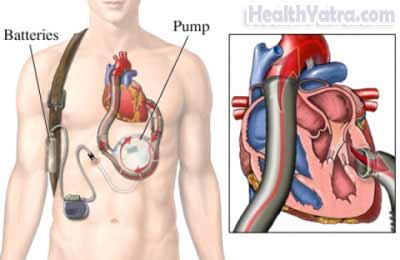সংজ্ঞা
A heart assist system implantation (also called a ventricular assist device, or VAD) is an artificial heart. This single-chamber artificial heart works by compressed air or battery power. The device boosts the function of a failing heart ventricle.

পদ্ধতির কারণ
Heart failure occurs when the heart is too weak to pump all the blood it receives and blood begins to back up. Blood can back up into the lungs and into the lower parts of the body. This can trouble breathing, cough, and swelling of the legs and ankles.
Getting a VAD is a way to improve the heart’s ability to pump without having a heart transplant. A VAD is sometimes referred to as a bridge to transplant, since it can be used to maintain people awaiting a heart transplant. This device can also be used for permanent treatment in people who:
- Are not candidates for transplant
- Do not respond to standard treatment
- Have a low risk of surviving one year
সম্ভাব্য জটিলতা
If you are planning to have VAD implantation, your doctor will review a list of possible complications, which may include:
- রক্তপাত
- রক্ত জমাট
- সংক্রমণ
- Device failure
- Adverse reaction to the anesthesia
- Kidney, lung, or heart damage
Factors that may increase the risk of complications include having:
- A serious infectious disease
- Advanced disease of vital organs other than the heart
- Blood clotting disorder
Also, if you have a small stature, you may not be able to get a VAD. The device is bulky. Newer generation continuous flow devices, which are much smaller, are being studied.
অস্ত্রোপচারের আগে আপনার ডাক্তারের সাথে এই ঝুঁকিগুলি নিয়ে আলোচনা করতে ভুলবেন না।
কি আশা করা যায়
পদ্ধতির আগে
If you need a VAD, it is because your heart is failing. Most likely, you will be on a list to receive a heart transplant. You may already be in the hospital. Your doctor will do many tests, for example:
- Echocardiogram —size, shape, and motion of the heart are examined using sound waves
- X-ray —uses radiation to take a picture of structures inside the body
- Cardiac Catheterization —to look for coronary artery disease
- Psychological and social system evaluations to make sure you are prepared to manage the device outside of the hospital
Leading up to the procedure, your doctor will instruct you to:
- Avoid eating for 8 hours before the procedure
- Stop taking aspirin or other anti-inflammatory drugs for one week before surgery. You may also need to stop taking blood-thinning medicines, such as:
- ক্লোপিডোগ্রেল (প্লাভিক্স)
- Warfarin (Coumadin)
এনেস্থেশিয়া
General anesthesia will be used. It will block any pain and keep you asleep through the surgery.
পদ্ধতির বর্ণনা
This procedure involves open heart surgery. The doctor will make an incision down the length of your breast bone. The breast bone will then be split and separated. You will be placed on a heart-lung machine. This machine will take the place of your heart and lungs during the surgery. The doctor will place the VAD into a pocket on the inside of the abdominal wall. The device will be sewn into your heart. It may also be sewn into your aorta, depending on the type of device.
অবিলম্বে প্রক্রিয়া পরে
You will be in the intensive care unit (ICU) after the procedure. You will be connected to many tubes. The medical staff will monitor you.
কতক্ষণ এটা লাগবে?
About 4-8 hours
এটা কতটা আঘাত করবে?
You will have pain from the surgery. Ask your doctor about medicine to help with the pain.
গড় হাসপাতালে থাকার
- 2-5 days in the ICU
- 2-4 weeks in a regular hospital room
পোস্টোপারেটিভ কেয়ার
ঘরে
আপনি যখন বাড়িতে ফিরে আসবেন, একটি মসৃণ পুনরুদ্ধার নিশ্চিত করতে নিম্নলিখিতগুলি করুন:
- Stay in contact with the heart center. You may be waiting for a heart transplant.
- Slowly increase your activity as instructed. Ask your doctor if you will be able to return to work.
- As prescribed by your doctor, take blood thinners. These will prevent blood clots.
- Be sure to follow your doctor’s instructions. She will tell you:
- How to take care of your VAD
- When to contact the hospital—Make sure that you know how to call your doctor if you have an emergency.
কখন গোসল করা, গোসল করা বা জলে ভিজানো নিরাপদ সে সম্পর্কে আপনার ডাক্তারকে জিজ্ঞাসা করুন।
আপনার ডাক্তারকে কল করুন
আপনি হাসপাতাল ছেড়ে যাওয়ার পরে, নিম্নলিখিতগুলির মধ্যে যেকোনটি ঘটলে আপনার ডাক্তারের সাথে যোগাযোগ করুন:
- জ্বর এবং ঠাণ্ডা সহ সংক্রমণের লক্ষণ
- লালভাব, ফোলাভাব, ক্রমবর্ধমান ব্যথা, অত্যধিক রক্তপাত, বা ছেদ স্থান থেকে কোনো স্রাব
- ব্যথা বাড়ছে
- One-sided weakness, blurry vision, or inability to talk
- A cold, pale or blue, numb, or painful extremity
- Cough, difficulty breathing, or chest pain
- বমি বমি ভাব বমি
- Problems with urination or bowel movements
- Redness or swelling in legs.
- Warning indications from the device
জরুরী পরিস্থিতিতে, অবিলম্বে চিকিৎসা সহায়তার জন্য কল করুন।
